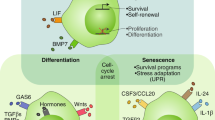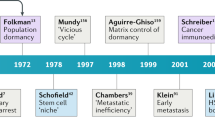Abstract
Tumor dormancy is a more common feature of cancer than previously appreciated. Growth of a population of fully malignant cells can be controlled by a variety of host mechanisms.
This is a preview of subscription content, access via your institution
Access options
Subscribe to this journal
Receive 12 print issues and online access
$209.00 per year
only $17.42 per issue
Buy this article
- Purchase on Springer Link
- Instant access to full article PDF
Prices may be subject to local taxes which are calculated during checkout
Similar content being viewed by others
References
Woodruff, M. Interaction of cancer and host [The Walter Hubert Lecture, 1982]. Br. J. Cancer 46, 313–322 (1982).
Callaway, M.P. & Briggs, J.C. The incidence of later recurrence (greater than 10 years): An analysis of 536 consecutive cases of cutaneous melanoma. Br. J. Plast. Surg. 42, 46–49 (1989).
Henderson, J.C., Harris, J.R., Kinne, D.W. & Hellman, S. Cancer of the breast. in Cancer: Principles and Practice of Oncology, 3rd edn. (eds. DeVita, V.J., Jr., Hellman, S. & Rosenberg, S.A.) 1197–1268 (Lippincott, Philadelphia, 1989).
Meeker, T. et al. Emergence of idiotype variants during treatment of B-Cell lymphoma with anti-idiotype antibodies. N. Engl. J. Med. 312, 1658–1665 (1985).
Ito, Y. & Miyamura, K. Clinical significance of minimal residual disease in leukemia detected by polymerase chain reaction: Is molecular remission a milestone for achieving a cure? Leuk. Lymphoma 16, 57–64 (1994).
Israeli, R.S. et al. Sensitive detection of prostatic hematogenous tumor Cell dissemination using prostate specific antigen and prostate specific membrane-derived primers in the polymerase chain reaction. J. Urol. 153, 573–577 (1995).
Loric, S. et al. Enhanced detection of hematogenous circulating prostatic Cells in patients with prostate adenocarcinoma by using nested reverse transcription polymerase chain reaction assay based on prostate-specific membrane antigen. Clin. Chem. 41, 1698–1704 (1995).
Folkman, J. Tumor angiogenesis. in The Molecular Basis of Cancer (eds. Mendelsohn, J., Howley, P.M., Israel, M.A. & Liotta, L.A.) 206–232 (Saunders, Philadelphia, 1995).
Bouck, N., Stellmach, V. & Hsu, S.C. How tumors become angiogenic. Adv. Cancer Res. 69, 135–174 (1996).
Vaage, J. & Harlos, J.P. Collagen production by macrophages in tumor encapsulation and dormancy. Br. J. Cancer 63, 758–762 (1991).
Penn, I. The effect of immunosuppression on pre-existing cancers. Transplantation 55, 742–747 (1993).
Greenberg, P.D. Adoptive T Cell therapy of tumors: Mechanisms operative in the recognition and elimination of tumor Cells. Adv. Immunol. 49, 281–355 (1991).
Boon, T., Cerottini, J.C. Van den Eynde, B., van der Bruggen, P., & Van Pel, A., Tumor antigens recognized by T lymphocytes. Annu. Rev. Immunol. 12, 337–365 (1994).
Kawakami, Y. et al. T-Cell recognition of human melanoma antigens. J. Immunother. 14, 88–93 (1993).
Eccles, S.A. & Alexander, P. Immunologically-mediated restraint of latent tumour metastases. Nature 257, 52–53 (1975).
Wheelock, E.F., Weinhold, K.J. & Levich, J. The tumor dormant state. Adv. Cancer Res. 34, 107–140 (1981).
Siu, H., Vitetta, E.S., May, R.D. & Uhr, J.W. Tumor dormancy. I. Regression of BCL, tumor and induction of a dormant tumor state in mice chimeric at the major histocompatibility complex. J. Immunol. 137, 1376–1382 (1986).
Weiss, L., Morecki, S., Vitetta, E.S., & Slavin, S., Suppression and elimination of BCL, leukemia by allogeneic bone marrow transplantation. J. Immunol. 130, 2452–2455 (1983).
Uhr, J.W., Tucker, T., May, R.D., Siu, H. & Vitetta, E.S. Cancer dormancy: Studies of the murine BCL, lymphoma. Cancer Res. 51, 5045S–5053S (1991).
Khazaie, K. et al. Persistence of dormant tumor Cells in the bone marrow of tumor Cell-vaccinated mice correlates with long-term immunological protection. Proc. Natl. Acad. Sci. USA 91, 7430–7434 (1994).
Matsuzawa, A. & Takeda, Y. The establishment of a tumor dormant state following a clinically complete cure of disseminated leukemia by chemotherapy in mice. in Premalignancy and Tumor Dormancy (eds. Yefenof, E. & Scheuermann, R.H.), Ch. 6, 89–103 (R.G. Landes Co., Austin, TX, 1996).
Stevenson, F.K., George, A.J.T. & Glennie, M.J. Anti-idiotypic therapy of leukemias and lymphomas. Chem. Immunol. 48, 126–166 (1990).
Racila, E. et al. Tumor dormancy and Cell signaling>. II. Antibody as an agonist in inducing dormancy of a B Cell lymphoma in SCID mice J. Exp. Med. 181, 1539–1550 (1995).
Levy, R. & Miller, R.A. Therapy of lymphoma directed at idiotypes. J. Natl. Cancer Inst. Monogr. 10, 61–68 (1990).
Yefenof, E. et al. Cancer dormancy: Isolation and characterization of dormant lymphoma Cells. Proc. Natl. Acad. Sci. USA 90, 1829–1833 (1993).
Vuist, W.M.J., Levy, R. & Maloney, D.G. Lymphoma regression induced by monoclonal anti-idiotypic antibodies correlates with their ability to induce Ig signal transduction and is not prevented by tumor expression of high levels of bcl-2 protein. Blood 83, 899–906 (1994).
Scott, D.W. et al. Lymphoma models for B-Cell activation and tolerance. II. Growth inhibition by anti-μ of WEHI-231 and selection and properties of resistant mutants. Cell. Immunol. 93, 124–131 (1985).
Vitetta, E.S. & Uhr, J.W. Monoclonal antibodies as agonists: An expanded role for their use in cancer therapy. Cancer Res. 54, 5301–5309 (1994).
Herlyn, D. & Koprowski, H. IgG2a monoclonal antibodies inhibit human tumor growth through interaction with effector Cells. Proc. Natl. Acad. Sci. USA 79, 4761–4765 (1982).
Steplewski, Z. et al. Isolation and characterization of anti-monosialoganglioside monoclonal antibody 19-9 class-switch variants. Proc. Natl. Acad. Sci. USA 82, 8653–8657 (1985).
Kaminski, M.S., Kitamura, K., Maloney, D.G., Campbell, M.J. & Levy, R. Importance of antibody isotype in monoclonal anti-idiotype therapy of a murine B Cell lymphoma: A study of hybridoma class switch variants. J. Immunol. 136, 1123–1130 (1986).
Denkers, E.Y., Badger, C.C., Ledbetter, J.A. & Bernstein, I.D. Influence of antibody isotype of passive serotherapy of lymphoma. J. Immunol. 135, 2183–2186 (1995).
Metzger, H. Transmembrane signaling: The joy of aggregation. J. Immunol. 149, 1477–1487 (1992).
Marches, R. et al. Tumour dormancy and Cell signaling-III: Role of hypercrosslinking of IgM and CD40 on the induction of Cell cycle arrest and apoptosis in B lymphoma Cells. Ther. Immunol. 2, 125–136 (1996).
Paget, S. The distribution of secondary growths in cancer of the breast. Lancet 1, 571–573 (1889).
Mintz, B. & Illmensee, K. Normal genetically mosaic mice produced from malignant teratocarcinoma Cells. Proc. Natl. Acad. Sci. USA 72, 3585–3589 (1975).
Albelda, S.M. Role of integrins and other Cell adhesion molecules in tumor progression and metastasis. Lab. Invest. 68, 4–17 (1993).
Jothy, S., Munro, S.B., LeDuy, L., McClure, D. & Blaschuk, O.W. Adhesion or anti-adhesion in cancer: What matters more? Cancer Metastasis Rev. 14, 363–376 (1995).
Liotta, L.A. & Stetler-Stevenson, W.G. Principles of molecular Cell biology of cancer: Cancer metastasis. in Cancer: Principles and Practice of Oncology, 4th edn. (eds. DeVita, V.T., Jr., Hellman, S. & Rosenberg, S.A.) 134–149 (Lippincott, Philadelphia, 1993).
Ronnov-lessen, L., Petersen, O.W. & Bissell, M.J. Cellular changes involved in conversion of normal to malignant breast: Importance of the stromal reaction. Physiol. Rev. 76, 69–125 (1996).
Vitetta, E.S., et al. Tumor dormancy and Cell signaling. V. Regrowth of the BCL, tumor after dormancy is established. Blood (in the press).
Butcher, E.C. & Picker, L.J. Lymphocyte homing and homeostasis. Science 272, 60–66 (1996).
Cyster, J.G., Hartley, S.B. & Goodnow, C.C. Competition for follicular niches excludes self-reactive Cells from the recirculating B-Cell repertoire. Nature 371, 389–395 (1994).
Nicolson, G.L. Cancer progression and growth: Relationship of paracrine and autocrine growth mechanisms to organ preference of metastasis. Exp. Cell Res. 204, 171–180 (1993).
Theodorescu, D., Cornil, I., Sheehan C., Man, M.S., & Kerbel, R.S., Ha-ras induction of the invasive phenotype results in up-regulation of epidermal growth factor receptors and altered responsiveness to epidermal growth factor in human papillary transitional Cell carcinoma Cells. Cancer Res. 51, 4486–4491 (1991).
Croxtall, J.D., Jamil, A., Ayub, M., Colletta, A.A. & White, J.O. TGF-β stimulation of endometrial and breast-cancer Cell growth. Int. J. Cancer 50, 822–827 (1992).
Plaisance, S. et al. Human melanoma Cells express a functional interleukin-2 receptor. Int. J. Cancer 55, 164–170 (1993).
Ramani, P. & Balkwill, F.R. Enhanced metastases of a mouse carcinoma after in vitro treatment with murine interferon gamma. Int. J. Cancer 40, 830–834 (1987).
Friedberg, E.C., Walker, G. & Siede, W. SOS responses and DNA damage tolerance in prokaryotes. in DNA Repair and Mutagenesis 407–464 (Am. Soc. for Microbiology Press, Washington, DC, 1995).
Israel, L. Tumor progression: Random mutations or an integrated survival response to Cellular stress conserved from uniCellular organisms? J. Theor. Biol. 178, 375–380 (1996).
Lundy Lovett, E.J., Lipow, D. & Whitte, C., Aneshesia, surgery, immuno suppression, and tumor growth. in Cellular Immune Mechanisms and Tumor Dormancy, (eds. Stewart, T.H.M. & Wheelock, E.F.) 155–167 (CRC Press, Boca Raton, FL, 1992).
Eccles, S.A. Dormancy in experimental solid tumour systems. in Cellular Immune Mechanisms and Tumor Dormancy, (eds. Stewart, T.H.M. & Wheelock, E.F.) 27–51 (CRC Press, Boca Raton, FL, 1992).
Noble, R.L. & Hoover, L. A classification of transplantable tumors in the Nb rats controlled by estrogen from dormancy to autonomy. Cancer Res. 35, 2935–2941 (1975).
Kluin, P.M. & Schuuring, E. Chromosomal translocations in B Cells of normal individuals: Preneoplasia or dormancy? in Premalignancy and Tumor Dormancy (eds. Yefenof, E. & Scheuermann, R.H.) Ch. 1, 1–15 (R.G. Landes Co., Austin, TX, 1996).
Fendly, B.M. et al. Characterization of murine monoclonal antibodies reactive to either the human epidermal growth factor receptor or HER2/neu gene product. Cancer Res. 50, 1550–1558 (1990).
Drebin, J.A., Link, V.C. & Greene, M.I. Monoclonal antibodies specific for the neu oncogene product directly mediate anti-tumor effects in vivo. Oncogene 2, 387–394 (1988).
Riethmiiller, G. et al. Randomised trial of monoclonal antibody for adjuvant therapy of resected Dukes' C colorectal carcinoma. Lancet 343, 1172–1174 (1994).
Stingl, G. & Bergstresser, P.R., Dendritic Cells: A major story unfolds. Immunol. Today 16, 330–333 (1995).
Pardoll, D.M. & Beckerleg, A.M. Exposing the immunology of naked DNA vaccines. Immunity 3, 165–169 (1995).
Hsu, F.J. et al. Vaccination of patients with B-Cell lymphoma using autologous antigen-pulsed dendritic Cells. Nature Med. 2, 52–58 (1996).
Author information
Authors and Affiliations
Rights and permissions
About this article
Cite this article
Uhr, J., Scheuermann, R., Street, N. et al. Cancer dormancy: Opportunities for new therapeutic approaches. Nat Med 3, 505–509 (1997). https://doi.org/10.1038/nm0597-505
Issue Date:
DOI: https://doi.org/10.1038/nm0597-505
This article is cited by
-
A signature of epithelial-mesenchymal plasticity and stromal activation in primary tumor modulates late recurrence in breast cancer independent of disease subtype
Breast Cancer Research (2014)
-
VaccImm: simulating peptide vaccination in cancer therapy
BMC Bioinformatics (2013)
-
Late recurrence after resection of mass-forming intrahepatic cholangiocarcinoma: report of a case
Surgery Today (2012)
-
Oligometastases revisited
Nature Reviews Clinical Oncology (2011)



